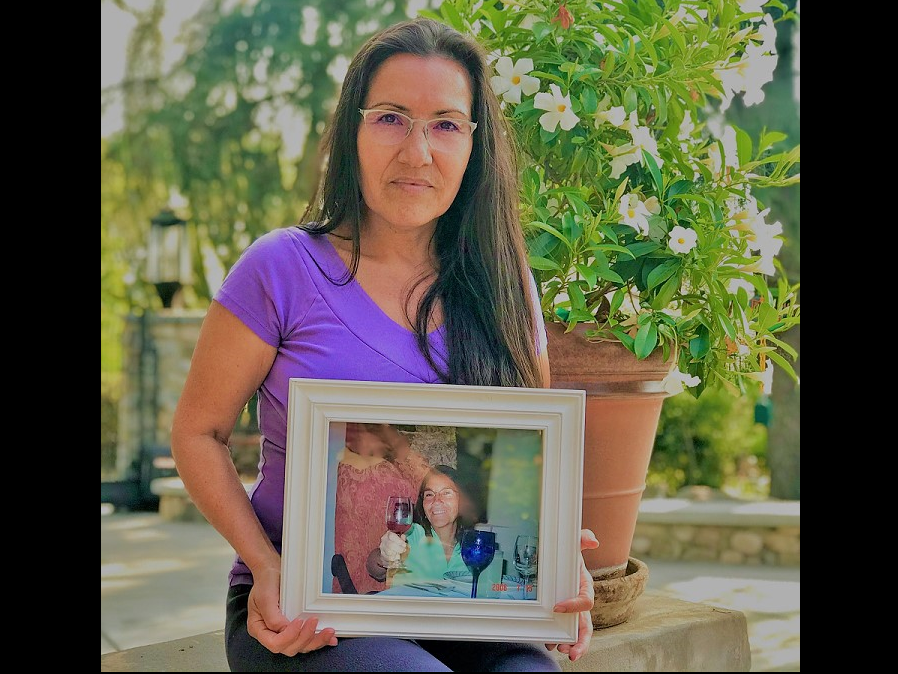Section Branding
Header Content
Domestic violence may leave telltale damage in the brain. Scientists want to find it
Primary Content
María E. Garay-Serratos was about 4 years old when she first saw her father assault her mother.
"My mom was hit a lot," says Garay-Serratos. "There was choking, a lot of shaking, objects thrown at her, shoved against the wall, thrown against appliances, dragged by her hair in the yard."
Garay-Serratos was still a child when she realized that the abuse was affecting her mother's brain. The insight came while her family watched a boxing match on TV.
"I remember seeing some of the symptoms that these boxers exhibited while they were in the ring," she says, "and I thought, 'Oh my God, that's my Mom.'"
Today, several decades later, Garay-Serratos runs a nonprofit in Southern California that's devoted to studying traumatic brain injury (TBI) from domestic violence. And agencies including the Centers for Disease Prevention and Control now recognize intimate partner abuse as a leading cause of TBI.
But researchers still know relatively little about brain injuries inflicted by a spouse or partner.
For decades, these TBIs were thought to be less damaging than the ones experienced by athletes and military personnel. Now, though, there are hints that this form of violence can cause a distinctive pattern of brain damage, one that is at least as disabling as the damage that occurs on a football field or a battlefield.
Grim statistics
About one in three women and a smaller proportion of men say they've experienced severe physical violence at the hands of an intimate partner. Studies suggest most women in this group have sustained at least one mild TBI, a brain injury commonly known as a concussion.
The symptoms usually resemble those seen in sports or the military: headaches, dizziness, fatigue, sensitivity to noise and light, and problems with memory and thinking.
But the underlying injury may be slightly different, says Kristen Dams-O'Connor, who directs the Brain Injury Research Center of Mount Sinai in New York.
This makes sense because domestic violence often includes several kinds of head trauma.
"We have repetitive head impacts, we have nonfatal strangulation, we have that shaking," Dams-O'Connor says. "There are these multiple etiologies of injuries that are overlaid upon each other."
And each form of injury tends to leave a distinct mark on the brain.
Shaking, for example, is more likely to disrupt connections between brain areas, while strangulation tends to affect brain areas involved in memory and balance.
Domestic violence also differs from sports in that it has no rules or offseason, Garay-Serratos says. "It's not like football, you know, where there's times out and referees."
Her father's violent episodes could go on for days, she says, and the abuse occurred over a span of 40 years.
Friends and relatives knew what was happening to her mother, but didn't intervene.
Her mother never tried to leave, perhaps in part because she'd come to California from a small town in Mexico, and was socially isolated. She was also devoted to the man who abused her, Garay-Serratos says.
A signature in the brain?
To learn more about how domestic violence alters the brain, Dams-O'Connor and a team of researchers studied brains from 14 women. All died with a documented history of intimate partner violence during a two-year period in New York City.
The median age at death was just 35.
At autopsy, every brain showed signs of damage, the team reported in the journal Acta Neuropathologica.
"Their brains carried an enormous burden of injury," Dams-O'Connor says, adding that for some of the women, it was probably the result of "multiple violent relationships."
Many of the women also had a history of brain-related health problems like stroke, or psychiatric or substance-use disorders. Whether brain injury contributed to these conditions is unclear, the researchers say.
But one finding was especially striking, Dams O'Connor says: half of the women had epilepsy.
"When you see rates of epilepsy as high as what we saw in this cohort," Dams-O'Connor says, "it does make you wonder [whether] traumatic brain injury initiated the development of that seizure disorder."
To confirm the findings from their small study, the team reviewed older autopsy results for 70 other women with similar histories. The records showed that the brains of these women also had scarring and other evidence of damage.
The damage overlapped with what's often seen in the brains of athletes who have experienced repeated head impacts.
But there were also some differences in women who experienced domestic violence, says Dr. Rebecca Folkerth from the office of the chief medical examiner in New York City and a clinical professor of forensic medicine at New York University.
"They really don't seem to have that same pattern in their brain," she says. "And it suggests that while they are getting repetitive brain injuries, it's of a different sort."
For example, the women were more likely to have evidence of disrupted blood flow in the brain — somewhat akin to the sort of damage caused by strokes. This kind of disrupted blood flow is rarely seen in the brains of athletes.
The pattern of brain damage associated with domestic violence may be detectable while an individual is still alive, the researchers say: Folkerth said that at least some of the changes were apparent using typical brain scans.
Ultimately, if they can identify this pattern in living patients, it might give doctors a way to intervene on behalf of patients who don't (or can't) talk about their abuse.
"Obviously that's our goal," Folkerth says.
Brain damage vs. CTE
One mystery, though, is how often TBIs from domestic violence result in chronic traumatic encephalopathy, or CTE.
CTE, which has been diagnosed in hundreds of former NFL players, causes the brain to shrink and show changes similar to what's seen in Alzheimer's. But CTE tends to alter different brain areas and is more likely to be associated with impulse control problems, aggression, and suicidality.
The team studying brains exposed to domestic violence expected to find at least a few cases of CTE.
"To our surprise, they didn't," Folkerth says.
Similarly, a study published in 2022 found that CTE was rare in deceased military personnel who'd experienced TBIs or been exposed to bomb blasts. The condition was present in just 10 of 225 brains.
But CTE has been found in the brains of at least two women who experienced domestic violence, according to the documentary This Hits Home, which features Garay-Serratos. One of those women was her mother.
The finding came years after Garay-Serratos was finally able to move her mother out of harm's way.
"I went to my mom's home, and she was literally crawling on the floor," Garay-Serratos says. Her mother told her: "I think your dad wants to kill me."
They left together and went to Garay-Serratos' home. But by this time, her mother's brain was ailing.
"She seemed like a different person," Garay-Serratos says. "Her gait was different, her memory. The headaches seemed to be getting worse."
So Garay-Serratos, by that time a PhD social worker, took her mother to doctor after doctor. They confirmed that her mother had memory and thinking problems. But they didn't connect those problems with her mother's history of abuse.
"I couldn't get the neurologists to understand that she had a lot of trauma to the head," Garay-Serratos says.
When Garay-Serrato's mother died in 2015, concussion experts asked to autopsy the brain.
The specialists all found evidence of Alzheimer's disease and brain injury, though they disagreed on whether there was also CTE.
The most pointed assessment came from Dr. Ann McKee, who runs the CTE Center at Boston University and has examined the brains of hundreds of athletes.
McKee concluded that Garay-Serratos' mother did have CTE. But even without that diagnosis, her mother's brain had sustained more damage than the brain of any athlete McKee had ever examined.
Now, Garay-Serratos goal is to keep that from happening to other women.
That's achievable, she says, if TBIs from domestic violence begin to get the sort of attention now paid to head trauma in sports and the military.
"This is a hidden and unrecognized pandemic," Garay-Serratos says. "We need a massive campaign."
If you or someone you know is affected by domestic violence, you can contact the National Domestic Violence Hotline. Their website is thehotline.org.


